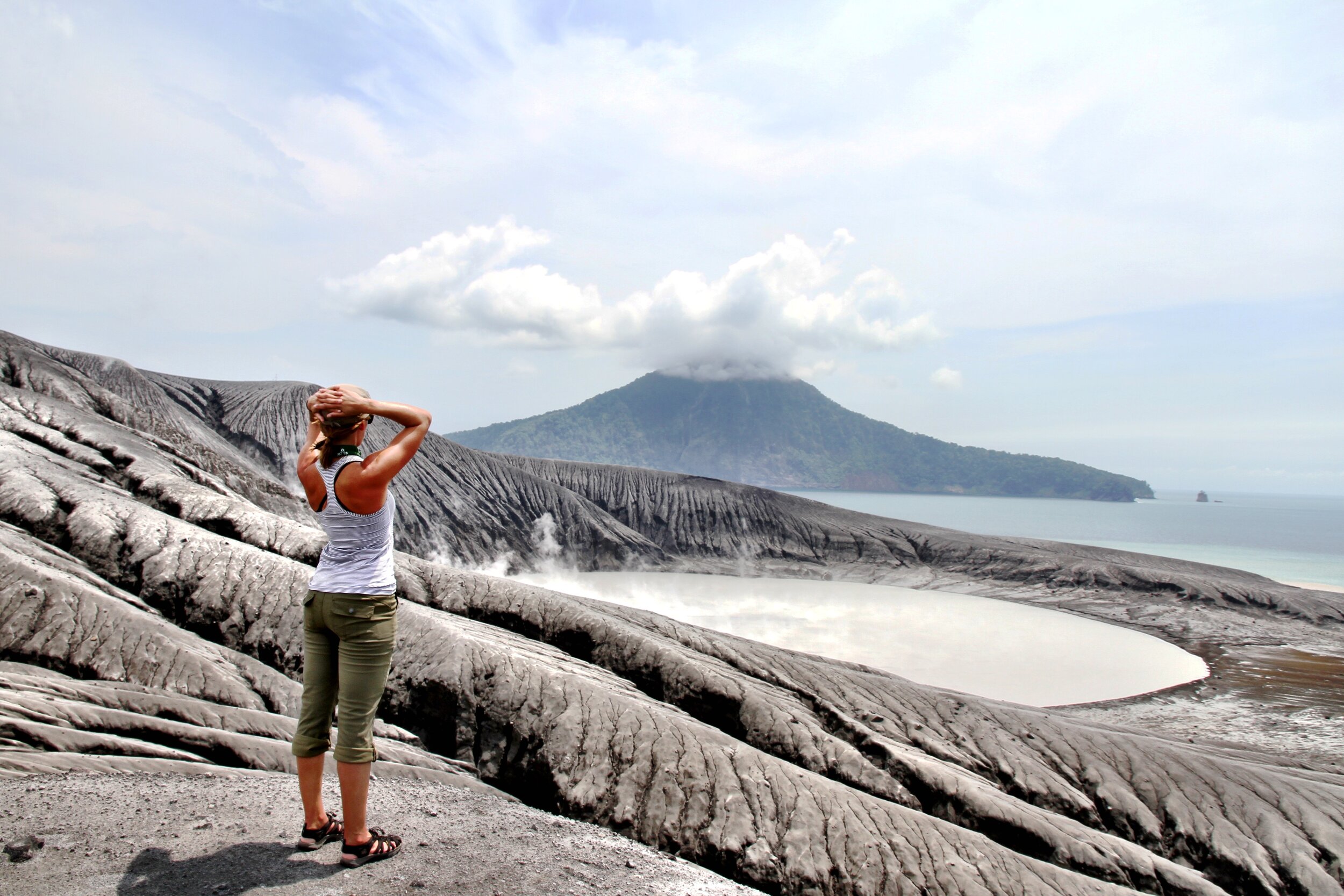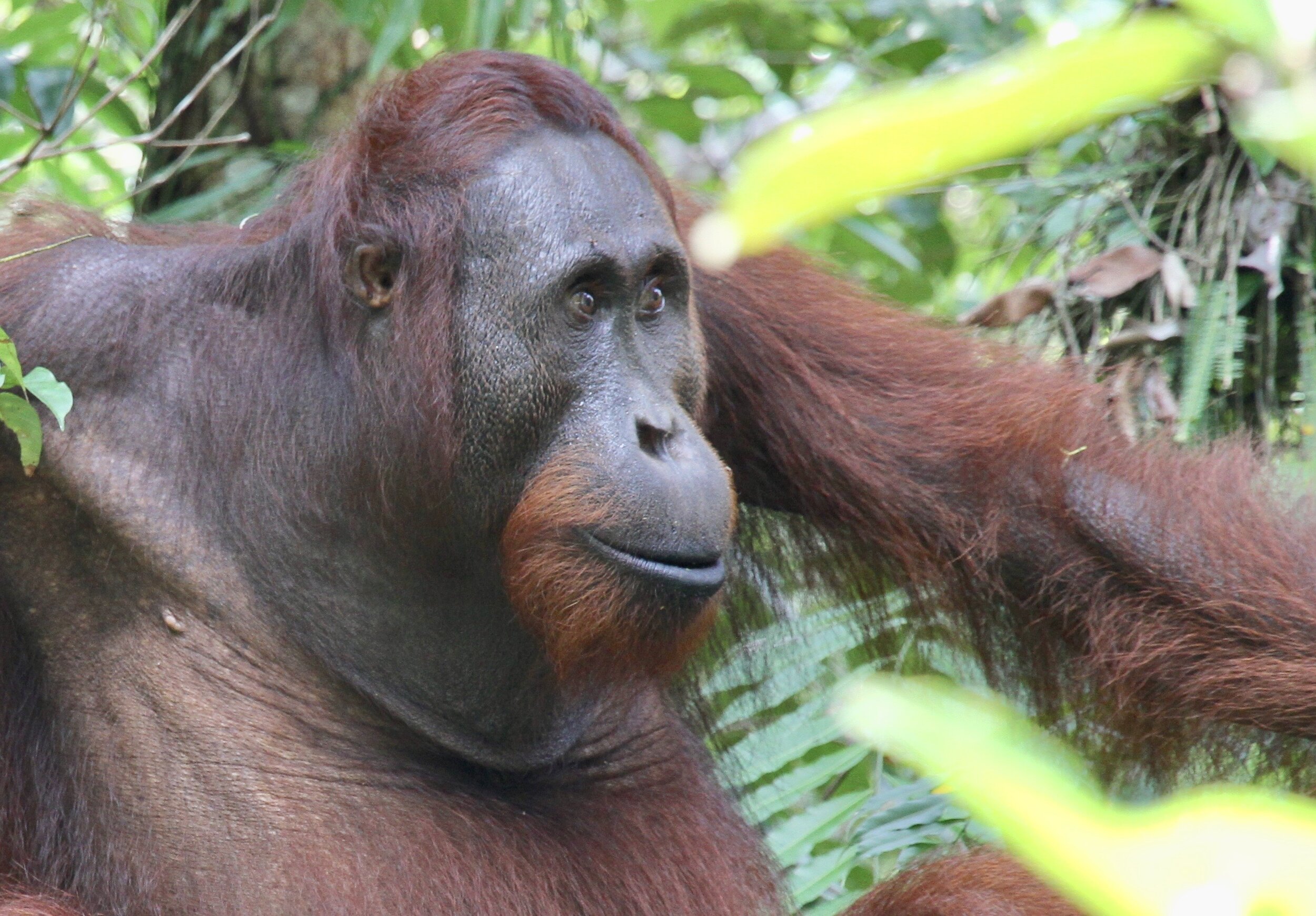Little Boy

HEAT IS COMING FROM ABOVE AND BELOW. On the ground a thick layer of dull ash lies over a dense, grey earth. Our steps are muffled. I take one more look back at our little bobbing boat, whose stark whiteness is in such strong contrast with the rest of the sullen, scorched scene that I have to squint against the glare through my sunglasses. I know full well that if things were to get ugly, our getaway craft would stand no chance. It would be obliterated, and so would we.
Our only way out.
Enough of the daydreaming. No time to dawdle. One need not be idle on this island. We need to see what we came to see then get down, get out, get as far away as possible.
Climbing higher and higher, we weave around rigid troughs gouged out by something now unseen, but whose memory is still fresh. No vegetation grows here. No fauna scampers under foot. Not one green leaf, not one crawling insect. No life remains, for a reason. Except us.
Again, we need to move. Faster.
My nose twitches as the smell of sulfur hits, and the heat intensifies. We’re getting closer, and we’re being baked from all angles. Toaster oven evenness. An angry puff of smoke snakes into sight from above the precipice. It’s moving quickly, unlike a cloud that floats by aimlessly, this smoke seems to be escaping.
Escape. I hope I’m not pushing my luck. Just yesterday I told my dad that if I were to go out this way, he better promise to get the details of this end inscribed on my tombstone. He didn’t think that was very funny.
One more push, and the bubbling caldera of Anak Krakatoa comes into view.
Standing at the Anak Krakatoa caldera with a view of Rakata (from the original archipelago) in the distance.
--|||--
SUNDA STRAIT: INDONESIA, 1883 – on a tiny uninhabited island floating between Sumatra and Java, Indonesia, trouble is brewing. The island, called Krakatoa, is composed of three volcanoes, which have been showing signs of unrest for months now and are about to explode. For more than 30,000 of the nearby civilians, native Indonesians and the Dutch colonialists, this is one of their last few days of life.
If the initial blast doesn’t kill them, they still need to survive a 120-foot wall of water.
--|||--
THE ERUPTION OF KRAKATOA is the stuff of legends. The word “Krakatoa” is synonymous with disaster and will give goosebumps to any history buff or geologist. Ash and dust from the explosion circled the planet for a year, changing weather patterns globally, and causing the “year without summer”. Atmospheric pressure was altered in the western hemisphere, and bodies washed ashore in Zanzibar.
The ground on Anak Krakatoa.
With a blast 10,000 times stronger than the atomic bomb dropped on Hiroshima, and heard as far away as Australia, the island itself was blown to pieces, leaving nothing but the southern wall of the largest volcano, Rakata.
Fast forward to 1927 – a new island and lava dome begin to emerge from the center of the Krakatoa archipelago. The rapid growth (about 5 inches per week, or 22 feet a year on average) and regular lava flows are too quick to be eroded by the sea. It is dubbed “Anak Krakatoa”, or Son of Krakatoa.
The southwestern wall of Anak Krakatoa collapsed in 2018. Here the sea meets with the boiling insides of the volcano at high tide.
--|||--
DECEMBER 22, 2018 – Anak Krakatoa has reached an impressive 1,108 feet (338 m) and has been quite a pain during his 90-year growth cycle, with some serious eruptive displays beginning June of this year.
The popular weekend getaway of Carita Beach in northwestern Java is filled with day trippers and backpackers, most of whom have settled down for the night. A gibbous moon has gifted campers with visual clarity out over the calm Sunda Strait. Without warning, 30 miles away, the southern wall of Krakatoa gives in after months of minor to medium eruptions, and the collapse sends a 32-foot high tsunami speeding toward Java…at night.
--|||--
STANDING ATOP THE YOUNG, angry son of the legendary Krakatoa, our guide recounts his experience one year ago, nearly to the day. He was one of the campers on Carita Beach, along with his wife and two young children. Thanks to the bright moon that night, he claims he was able to see a disturbance, a “wall of water” and get his family to safety. This was not the case for the 425 others who were killed, or the 14,000+ who were injured.
Our island accommodations for the night.
That night we camped on what remains of the original Krakatoa explosion. Rakata, once the main volcanic vent, is now a peaceful island lush with vegetation and creeping with animal life; but the beach, littered with chalky pumice stones and lava rocks tell a different, destructive story, and the dead reef at the coastline shows that that destruction is ongoing.
Fer discussing what he saw under the water at the coastline of Rakata.
The black beach of Rakata.
Tomorrow morning we will begin our journey away from Krakatoa and the Sunda Strait. The December, 2018 tsunami raced the 30 miles to Java in under 25 minutes – our boat ride over that same course will take 2.5 hours. Once back at Carita Beach we still won’t be in the clear. The abandoned resorts, forgotten restaurants, and vacant homes are a testament to the forever impending danger of northwestern Java.
But tomorrow will come. We will not be pulled out to sea in our sleep, nor will our boat be overcome by an angry wall of water. We will make it back to Java without trouble, and once on Carita Beach, we will drive right out of harm’s way. We will not be two more victims of the world’s most notorious volcano.
For now, Krakatoa is quiet.
———-
VERDICT: Quite Harmful - for the 40,000+ people who over centuries have been near Krakatoa at the wrong time.














